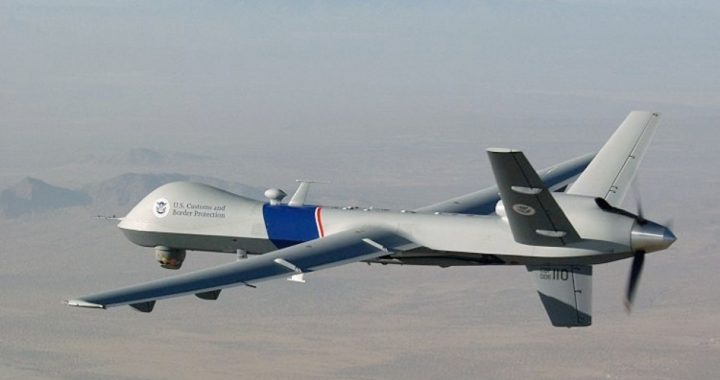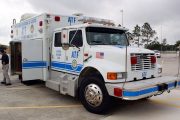
The Freedom of Information Act (FOIA) lawsuit filed by the Electronic Frontier Foundation (EFF) against the Federal Aviation Administration (FAA) regarding the licensing of domestic drones has finally produced documents detailing the use of drones in the United States.
According to a blog post written by EFF staff attorney Jennifer Lynch, the information obtained by the FAA includes “details about the specific drone models some entities are flying, where they fly, how frequently they fly, and how long they stay in the air.”
Thousands of pages were delivered to the EFF in response to the FOIA request submitted in April 2011. Prior to the documents dumped on the EFF last week, the FOIA petition had already been answered in part by a list of all the entities (public and private) licensed by the federal government to operate drones in the skies over the United States.
In her report, Lynch states:
The 18 entities represented in the files include police departments from Seattle, Washington to North Little Rock, Arkansas; about 10 public colleges and universities; a few federal agencies, including the USDA and the Department of Energy — Idaho National Lab; and other entities like the City of Herrington, Kansas and the Mississippi Department of Marine Resources. For every entity, the files include the actual Certificate of Authorization (COA) application information submitted to the FAA (for each entity, that file is called “COA.xls”), and many other supporting records. The files go back several years and include COAs for every year that the entity has had drones. For some entities this is as early as 2004.
Although the EFF has not been able to scour all the information obtained in the files delivered by the FAA, links to the files are provided on their website so that citizens may peruse them on their own and uncover who is flying drones near them, as well as how many drones have been or will be deployed.
The New American has reviewed some of this information, and while it is disturbing, it is hardly thorough enough to allow a complete picture to be painted of the enormous potential for Fourth Amendment violations on the part of those who are now, or will soon be, at the joystick of these remote control spy planes.
Below is a brief sample of some of the information contained in the FAA disclosure regarding the use of drones by local law enforcement. As readers will discover for themselves, often the police department’s description of their intended use for the drones does not match the scope of the permitted flight plans as indicated on maps included in the files.
For example, the Seattle Police Department was issued a license to fly drones within their jurisdiction, and it reported the following intent for their use of them:
The objective of our program is to create a higher standard of safety for members of our community by utilizing the Draganflyer [sic] X6 Unmanned Aerial Vehicle in support of numerous Law Enforcement related functions which could include but are not limited to:
1) Crash site related to interstate transport of hazardous materials
2) Crash site related to railroad transport of hazardous materials
3) Search & Rescue operations
4) Tactical support of Law Enforcement operations
Within those four objectives are several constitutionally suspect issues. For example, no precise guidelines are mentioned regarding the scope of the searches to be conducted by drone, and there is no indication of how the “tactical support of law enforcement operations” will be conducted so as not to violate the Fourth Amendment’s prohibition on warrantless searches and seizures. That is to say, will officers of the Seattle Police Department be required to submit an affidavit “particularly describing the place to be searched and the persons or things to be seized” in advance of launching the drone?
Notably, the documents obtained by the EFF included mention of one request for better snooping capability on the part of a city government that was actually denied by the FAA.
As The New American reported last March, law enforcement in Ogden, Utah, was giddy about the imminent deployment of the Crime Blimp that it planned to use to link all of the town’s private and public closed-circuit TV (CCTV) cameras into one massive and powerful crime-fighting, monitoring matrix. According to published reports, the Utah Department of Transportation and the Utah Transit Authority volunteered to allow their cameras to be linked with the new video center headquarters that was scheduled to be centered in the remodeled offices of the police department.
City officials announced plans to launch the blimp last April. The unique surveillance device is currently being developed by Weber State University’s Utah Center for Aeronautical Innovation and Design. The guts of the machine were engineered to be completely integrated with both the existing surveillance cameras and the video-monitoring headquarters that will come online any day. The originally stated goal was for the complete coordination and integration of all the cameras, the center, and the blimp to be ready last summer.
Unfortunately for Ogden police, but fortunately for its citizens, the FAA rejected the city’s plan for the blimp, citing safety concerns surrounding the operation of the blimp at night. The FAA in its rejection notice did not mention the fact that such surveillance was likely to result in daily deprivations of the constitutional rights of the 82,000 residents of Ogden.
Equally disturbing to constitutionalists should be the drone-deploying alliance formed between law enforcement and the public university located in Ogden, Weber State University. Such cooperation between police and professors may soon become commonplace given details of a drone pilot program being developed in Ohio.
One such institution, Eastern Gateway Community College, offers the following description of their intended use of drones:
The Eastern Gateway Community College (EGCC) intends to provide training in the operation of UAS including the use and integration of UAS payload systems as a safe and effective tool for law enforcement, emergency responders and other government agencies.
EGCC is one of 30 Ohio community colleges and universities selected as sites for terrorism training under the Ohio Homeland Security Training Alliance. The EGCC UAS training program will be included as a course offered to emergency service professionals.
The EGCC UAS program will provide emergency service professionals access to standardized training which will include simulated UAS operations, scenario based flight training and best practices and procedures. As Emergency service administrators become more familiar with UAS applications, they will have access to relevant and practical training, reducing the need of individual COA requests.
Is there any doubt that soon classes will begin appearing in college course catalogs that promise to train students to operate drones? Is the government set to not only provide grants to universities to fund the development of new and more powerful drones, but to teach students how to fly them once they are manufactured?
The EFF is teaming up with online FOIA facilitator MuckRock in an effort to encourage the “Internet community to help us push for more transparency around the use of drones for domestic surveillance.” Citizens who would like to uncover documents pertaining to the use of drones in their area may obtain and submit an online public records request by visiting the MuckRock website.



